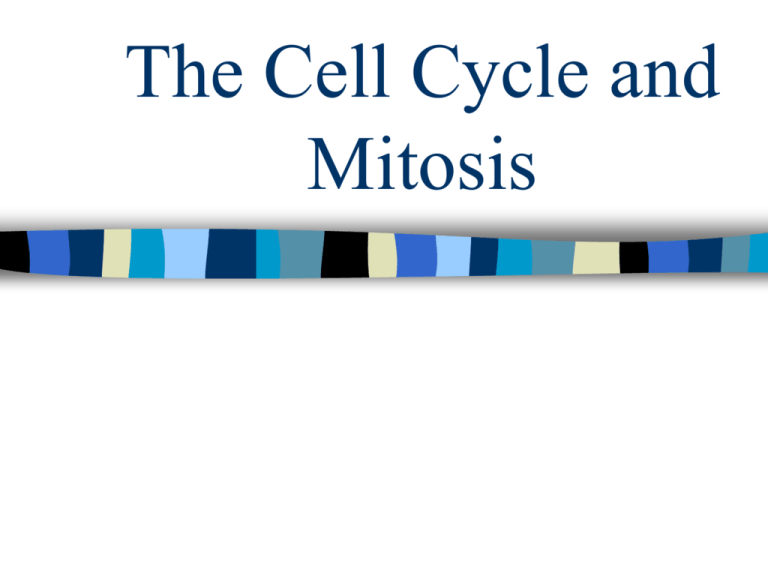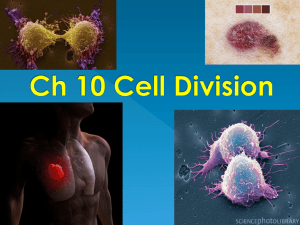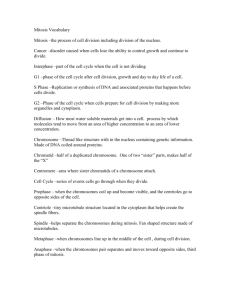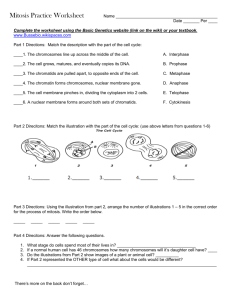
The Cell Cycle and
Mitosis
Today’s Objectives
The student will be able to identify the
phases of the cell cycle and mitotic
stages by description and or graphic
representation.
Some Definitions
Somatic Cells – body cells
– Produced through mitosis
– Has 46 chromosomes (23 pairs)
Homologous Chromosomes – each
member of a chromosome pair
Diploid (2n) – total of 46 chromosomes
in people – zygote & somatic cells
Haploid (n) – total of 23 chromosomes
in people, gametes (sperm & egg)
Chromosomes
Genetic information is passed from one
generation to the next on chromosomes.
Before cell division, each chromosome is
duplicated, or copied.
Chromosomes
Copyright Pearson Prentice Hall
Each chromosome
consists of two
identical “sister”
chromatids.
Each pair of
chromatids is
attached at an area
called the
centromere.
Sister chromati
Centromere
Copyright Pearson Prentice Hall
The Cell Cycle
The
sequence of growth and
division of a cell.
95% of cell cycle in
interphase
5% of cell cycle in mitosis
Cell Cycle
M Phase
Copyright Pearson Prentice Hall
Interphase
Growth
Stage 1 (G1)
Synthesis
Growth
Stage (S)
Stage 2 (G2)
Events of the Cell Cycle
Events of the Cell Cycle
During G1 (Growth Stage 1)
–Cell increases in size
–synthesizes new proteins and
organelles
Copyright Pearson Prentice Hall
Events of the Cell Cycle
During the S phase (Synthesis
Phase),
• chromosomes are replicated
• DNA synthesis takes place
Once a cell enters the S phase, it
usually completes the rest of the
cell cycle.
Copyright Pearson Prentice Hall
Events of the Cell Cycle
The G2 Phase (Second Growth
Phase)
• organelles and molecules required
for cell division are produced
• Once G2 is complete, the cell is
ready to start the M phase—Mitosis
Copyright Pearson Prentice Hall
Polleverywhere.com Bell-Ringer
http://www.polleverywhere.com/multiple
_choice_polls/AjzgwYyKmcFD8AQ
Mitosis
Happens
in all cells
Cell division process
5 major stages
Prophase
Nuclear envelope disappears
Chromosomes condense – can see
sister chromatids
and centromere
Spindle forms
Spindle
forming
Mitosis
Prophase
Prophase is the first and
longest phase of
mitosis.
The centrioles separate
and take up positions
on opposite sides of
the nucleus.
Centromere
Copyright Pearson Prentice Hall
Chromosom
es
(paired
chromatids)
Metaphase
Chromosomes
move to the
equator of spindle
Each chromatid is attached to
spindle with centromere
Centriole
Mitosis
Metaphase
The second phase of
mitosis is metaphase.
The chromosomes line
up across the center
of the cell.
Microtubules connect
the centromere of
each chromosome to
the poles of the
spindle.
Spindle
Copyright Pearson Prentice Hall
Anaphase
Centromeres
split
Sister chromatids are pulled
apart to opposite poles of the
cell
Each chromatid is now a
separate chromosome
Mitosis
Anaphase
Individual
Anaphase is the thirdchromosomes
phase of mitosis.
The sister chromatids
separate into individual
chromosomes.
The chromosomes
continue to move until
they have separated
into two groups.
Copyright Pearson Prentice Hall
Telophase
Nuclear
envelopes (2) reform
Chromosomes begin to uncoil
Mitosis
Telophase
Telophase is the
fourth phase of
mitosis.
Chromosomes gather
at opposite ends of
the cell and lose
their distinct shape.
Copyright Pearson Prentice Hall
Cytokinesis
Cytoplasm
divides
Two new daughter cells are
now separate
Cytokinesis
During cytokinesis, the
cytoplasm pinches in
half.
Each daughter cell has
an identical set of
duplicate
chromosomes
Copyright Pearson Prentice Hall
Crashcourse Mitosis Video
http://www.youtube.com/watch?v=L0kenzoeOM







